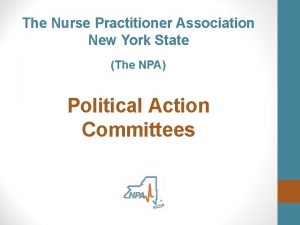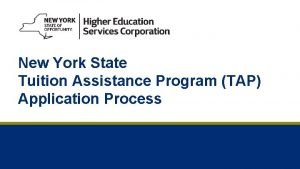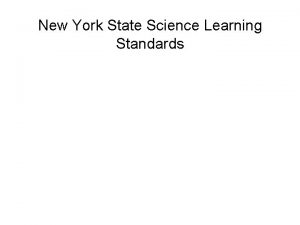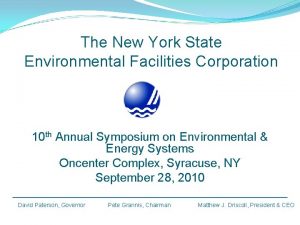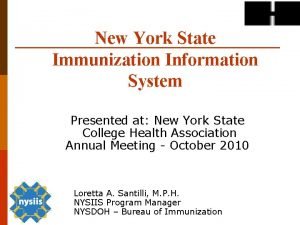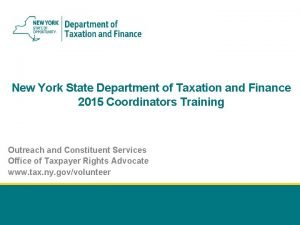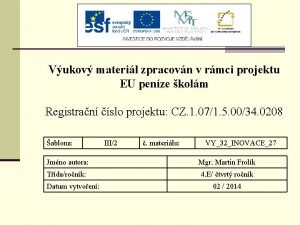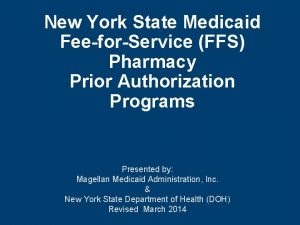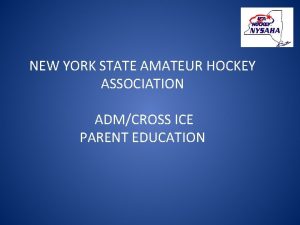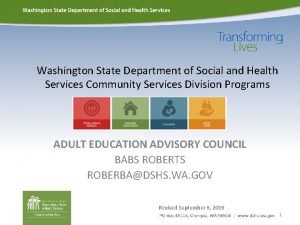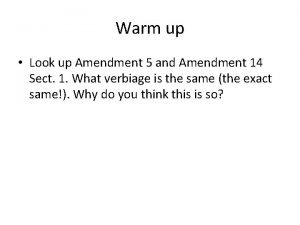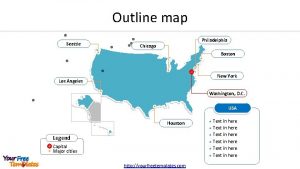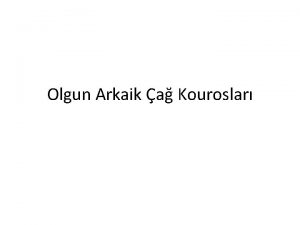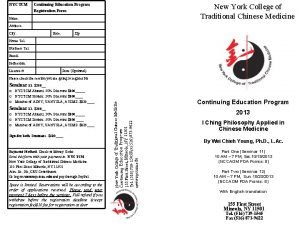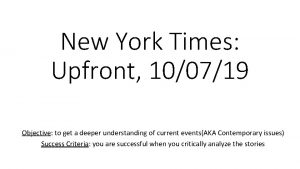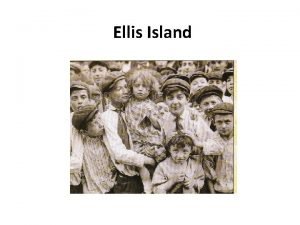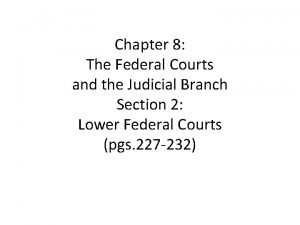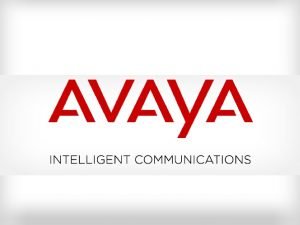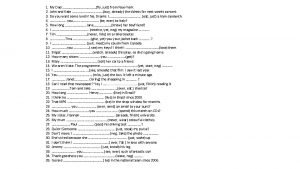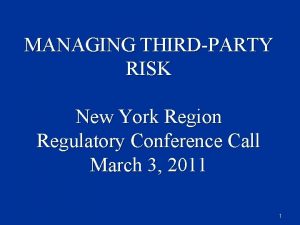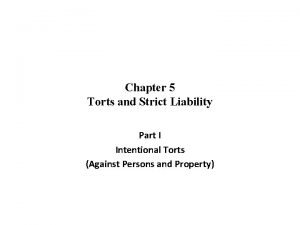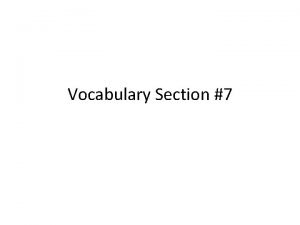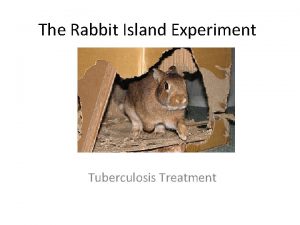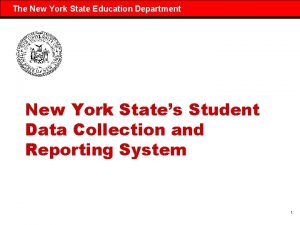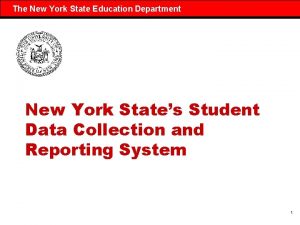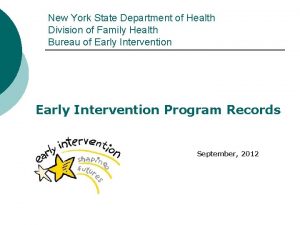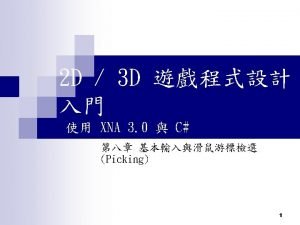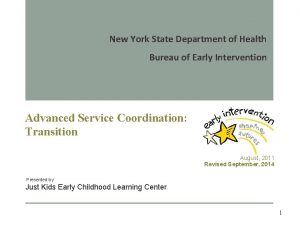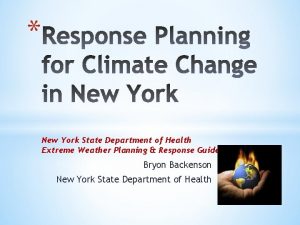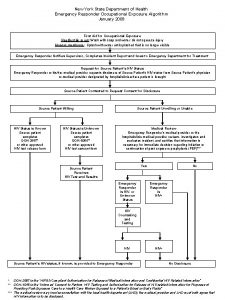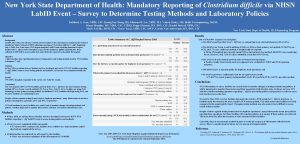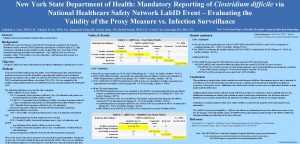New York State Department of Health Division of










































































- Slides: 74

New York State Department of Health Division of Family Health Bureau of Early Intervention Advanced Training: Early Intervention Evaluation, Assessment, and Eligibility Determination December 2011 Updated August 2012 1

Unit #1 Welcome Introductions Course Overview 2

Training Agenda • Welcome, Introductions and Course Overview • Review of MDE Requirements • Components of an Evaluation • Determining Eligibility Break • Reporting Results • Ongoing Assessment and Continuing Eligibility • Review Activity and Course Evaluation

Learning Outcomes • Increase understanding of the required regulatory elements and best practices for conducting a Multidisciplinary Evaluation • Enhanced knowledge of eligibility criteria and determinations • Understand implement best practice procedures for reporting evaluation results • Increase understanding of assessing a child’s progress and ongoing eligibility

Activity Evaluation Essentials 5

Unit #2 Review of MDE Requirements

Regulation Changes as of June, 2010 • 69 -4. 1(h): Clarifies that the physical domain includes oral motor feeding and swallowing disorders • 69 -4. 8(a)(6)(i): Use of standardized instruments approved by the Department • 69 -4. 8(a)(9)(i): Submission of written summary and report • 69 -4. 8(a)(9)(iii): Eligibility statements must provide sufficient detail to demonstrate child’s eligibility • 69 -4. 23: New section of regulation for initial and continuing eligibility, including communication only criteria 7

Requirements for Conducting the MDE • Must be conducted in a professional, objective manner by personnel trained to use appropriate methods and procedures • Must use age-appropriate, approved, standardized instruments and procedures that are valid, reliable, and contain appropriate levels of sensitivity and specificity • Must be conducted in a setting appropriate to the needs of the child • Must consider the unique characteristics of the child EI Regulation 69 -4. 8 8

Requirements for Conducting the MDE (cont’d. ) • Include informed clinical opinion and observations • Include several sources of information about the child • Include parent involvement in the evaluation • Use of non-discriminatory procedures; responsive to cultural/linguistic background • Must assess all five developmental domains EI Regulation 69 -4. 8 9

Requirements for Conducting the MDE (cont’d. ) ● Must include a health assessment of the child • Review of other pertinent records or external evaluations, with parent consent ● Must include assessment of transportation needs ● Must include the Parent Interview ● May include the optional Family Assessment ● Completed with sufficient time to develop the IFSP within 45 days of referral EI Regulation 69 -4. 8 10

Assessment Tools 11 • No single procedure or instrument can be used as sole criterion or indicator of eligibility • This does not mean two tests must be conducted, unless the child’s developmental status clearly indicates the need for more than one test

Assessment Tools and Results Evaluators should: • choose from a variety of assessment tools • use DOH-approved standardized assessment tools normed for the child who will be assessed • utilize appropriate assessment materials specific to the child’s needs • be familiar with the assessment tool: scoring and interpreting 12

Assessment Tools and Results (cont’d. ) • If modifying the assessment tool, use the findings for descriptive purposes only • Use clinical opinion in interpreting test results • Incorporate clinical expertise when assessing very young children (less than a year old) • Adjust for prematurity as needed 13

The “Team” Approach • The evaluation is conducted as a “team” collaboration among the evaluators, not as individual evaluations • Evaluation agencies must develop evaluation procedures to ensure the integration and coordination of evaluation services 14

Integrating and Coordinating Evaluation Results All sources of information obtained during the MDE must be synthesized and interpreted together to determine eligibility, including: 15 ● Standardized assessment results ● Informed Clinical Opinion, including clinical clues and predictors of a continued delay ● Child’s Health Assessment ● Parent Interview (and optional Family Assessment) ● Other assessment tools (non-standardized) ● Additional sources of information (direct observation, day care providers, external evaluations)

Unit #3 Components of an Evaluation 16

Parent Interview • Described in EI Regulation 69 -4. 8(a)(4) 17 ● A required component of the MDE ● Used to determine the family’s concerns, priorities, and resources related to the child’s development ● Others can be interviewed, with parent consent ● Must be fully documented in the evaluation report and summary

Examples of Parent Interview Questions 18 ● Describe your child’s typical daily routine. ● Describe your child’s favorite activity or toy? How does he/she play with it? ● What new things has your child recently learned? ● How does your child play with you and others?

Family Assessment Assists the family in assessing their own concerns, priorities, and resources related to enhancing their child’s development. It may include how the family views: 19 • their knowledge and need for information about a child’s delay or disability • the family’s composition (including siblings and extended family) • the family’s demographics and specific circumstances

Family Assessment 20 • family values and culture • the family’s current support systems and resources (including extended family) • the family’s stressors, tolerance for stress, and coping mechanisms and style • family interaction and patterns of parenting style • caregiving skills and sharing of caregiving responsibilities

Examples of Family Assessment Questions 21 ● Are you currently using any supports in the community? ● What activities in the community would you and your family like to become involved in? ● Do you think you need more information about your child’s development or disability? ● Do you need help in accessing child care or day care for your child? ● Do you have adequate time for yourself?

Parent Interview vs. Family Assessment Parent Interview Family Assessment Required Voluntary Focuses on the child Focuses on the family Assesses child’s strengths and developmental needs from the parents’ perspective Assesses the family’s needs in enhancing their child’s development Others familiar with child can participate, with parent consent Child’s Parent(s) Results used to inform evaluation and Results identify resources and other eligibility conclusions supports to help the family meet their child’s needs Conducted by a member of the evaluation team properly trained in family assessment Must be completed as part of the MDE Can be completed as part of the MDE or as a supplemental evaluation at a later date

Cultural and Linguistic Considerations “Responsiveness to the cultural background of the family shall be a primary consideration in all aspects of evaluation and assessment. ” EIP Regulations 69 -4. 8(a)(14)(i) 23

Cultural and Linguistic Considerations The evaluator should: 24 • Assess the family’s culture, parent priorities, parenting styles, and support system • Ascertain the dominant language of the child and the language preference of the parent • Assess the need for a bilingual evaluation or use of an interpreter/translator • Consider use of cultural/community advocate where available

Cultural and Linguistic Considerations (cont’d. ) • Understand the limitations of standardized tests for culturally and linguistically diverse populations • Provide a child who is exposed to more than one language with the opportunity to respond in any of the languages • Understand other modes of communication used, e. g. body language, posturing, etc. • Understand the cultural and familial differences regarding eye contact, gender roles, play, and social interactions 25

Unit #4 Determining Eligibility 26

Points to Remember 27 • No single measure or source of information may be used to establish a child’s eligibility; eligibility is not based on test scores alone • It is possible for a child to have a developmental delay and not meet the initial eligibility criteria for the EIP (e. g. , “late talkers” who appear to be experiencing a normal variation in development) • It is also possible that a child may have a delay, but not qualify for services under the Early Intervention Program • Some children who are not eligible may continue to receive screening and tracking, if they appear to be at risk for developmental delay

28

29

Eligibility Criteria Based on Communication Delay Only • For children found to have a delay in only the communication domain, delay is defined as: • Score of 2 SDs below the mean in the entire communication domain; OR • If no standardized test is available or appropriate for the child, OR the tests are inadequate to accurately represent the child’s development in the informed clinical opinion of the evaluator, a delay in communication shall be a severe or marked regression in communication development 30

Eligibility Criteria Based on Communication Delay Only EI Regulations Section 69 -4. 23(a)(2)(iv) outline specific eligibility criteria for children younger than and older than 18 months of age. 31

What is Informed Clinical Opinion? The best use of quantitative and qualitative information by qualified personnel regarding a child and family. Such information includes: • The child’s functional status • Rate of change in development • The child’s prognosis 10 NYCRR 69 -4. 1(x) 32

What is Informed Clinical Opinion? (cont’d. ) • Must always be used in combination with diagnostic instruments to determine the degree of delay and to formulate an eligibility statement • Especially important when standardized instruments are unavailable or inappropriate due to child’s age, culture, language or developmental problem OR did not accurately reflect the child’s developmental level • Needs to reflect specific and detailed information, and behavioral observations 33

What is Informed Clinical Opinion? (cont’d. ) 34 ● Should document a preponderance of clinical clues associated with the disorder and/or likelihood of continued delay ● Based on recognized clinical practice guidelines or professional standards

Preponderance of Clinical Clues • Means the greater weight or the majority of clues which are predictors of continued delay for the age of child being evaluated. • EIP regulation does not quantify that a specific number or a specific percentage of clues must be present in order to document a developmental delay or a preponderance of clinical clues. 35

Isolated Issue or Developmental Delay? • Feeding • Sensory • Articulation/Phonology • Receptive/Expressive Language • Fine/Gross Motor 36

Isolated Issue or Developmental Delay? A Sample Comparison Area of Concern 37 Isolated Issue Possible Developmental Delay Feeding Picky eater Failure to thrive Sensory Wants tags removed from their clothing Cannot tolerate touch, hugs. Extremely selective about their clothing. Will not bathe in the tub. Articulation or Phonology Sporadic substitution of sounds (“tup” for “cup”) Largely unintelligible speech, multiple speech errors – especially past expected age Receptive or Expressive Late talker Frequent tantrums when not understood, large discrepancy between expressive and receptive skills – vastly dependent upon age of child Fine or Gross Motor Late walker High or low muscle tone, orthopedic issues, consistently walking on tip toes – vastly dependent upon age of child

Making an Eligibility Determination Initial Eligibility for the EIP cannot be established solely by: • A delay of 2 SD below the mean or 33% in either gross or fine motor skills. • A delay of 2 SD below the mean in either expressive, receptive, or articulation skills. Initial eligibility is based on a delay in the entire domain, not a selected portion. A delay of 2 SD or more below the mean in either gross motor or fine motor skills can help to establish a child’s eligibility for the EIP, but alone it is not sufficient. 38

Making an Eligibility Determination • The evaluator must determine that there is a significant enough impact on the child’s development and functioning to meet the minimum eligibility criteria for the EIP, including initial eligibility criteria for communication delay only. • The evaluator must determine whether all composite findings, considered together using informed clinical opinion, are consistent with initial eligibility criteria 39

The Physical Domain • The evaluator is required to assess the child’s fine and gross motor skills, vision, hearing, oral motor and feeding, sensory functioning, and neurological development (if appropriate) • A total physical domain score as a result of standardized testing must be determined and reported. • Evaluators are not expected to work outside their professional scope of practice when assessing the physical domain. 40

BREAK 41

Unit #5 Reporting Results 42

The Evaluation Report and Summary 43 • Must contain enough supporting documentation to ensure all members of the IFSP team understand how the child is eligible or not eligible • Must contain sufficient information/ description to assist and inform the IFSP team in planning for the appropriate services

The Evaluation Report and Summary (cont’d. ) 44 • Must be submitted to the parent, early intervention official, and initial service coordinator; and with parental consent, the child's primary health care provider • It should be apparent to the lay reader of the evaluation report and summary how the team formulated the determination of eligibility • The MDE report and summary must contain the same required components

Meet “Anderson Lane” Multidisciplinary Evaluation Report 45

Required Components of the MDE Report and Summary The evaluation report should be created as one cohesive document that addresses all developmental domains and includes: 1. identification of persons conducting the evaluation 2. description of the assessment process and conditions under which it was conducted 3. a clear, detailed statement of eligibility 46

Required Components of the MDE Report and Summary (cont’d. ) 4. family’s belief of whether the child’s responses were optimal 5. description of the assessment tools used and full explanation of scores 6. justification for use of non-standardized instruments 7. an assessment of the unique needs of the child in each developmental domain, including the identification of services appropriate to meet those needs 47

Contents of the Report The MDE report and summary should also include: 1. a definition of clinical terms 2. parent’s feedback and response to their concerns regarding the evaluation 3. description of test modifications 4. documentation of evaluator observations and qualitative concerns 48

Contents of the Report (cont’d. ) 5. interpretation of child’s responses rather than only listing passes and failures 6. documentation of child’s transportation needs 7. description of child’s learning ability – what adaptations worked to help the child participate during the evaluation 8. characteristics of the developmental delay, including the severity and how this impacts the child’s functioning 49

Contents of the Report 9. reporting of results of parent interview and optional family assessment 10. detailed reporting of child’s medical history 11. documentation of vision and hearing screening 12. reason for referral 13. description of significant background information 50

Eligibility Statement “The evaluation report and summary shall include a statement of the child's eligibility, including diagnosed condition with a high probability of delay, if any, and/or developmental delay in accordance with section 694. 23(a) of this Subpart. ” 10 NYCRR 68 -4. 8(a)(9)(iii) 51

Eligibility Statement – “Lily” Acceptable: "Based on a score of 2. 3 SD below the mean using the PLS-4, direct observation, clinical opinion and parent report, Lily demonstrates delays consistent with ICD code 315. 3 and is eligible for early intervention services. She would benefit from services to increase presymbolic language skills, including attention, engagement, and eye contact. " 52

Eligibility Statement – “Tiffany” Acceptable: "Tiffany is eligible for the Early Intervention Program based on a confirmed diagnosis of extreme prematurity consistent with ICD code 765. 03. Results of the PLS-4, ELAP, Oral Motor Feeding Rating Scale, PDMS-2, parent interview, and direct observation indicate a 33% delay in cognitive, adaptive and communication development, and a 40% delay in motor development. Services to address fine and gross motor delays and feeding skills are recommended. Cognitive and communication skills should also be addressed. ” 53

Eligibility Statement – “Anderson” Acceptable: "Based on clinical observations, parent interview, and results of the Battelle Developmental Inventory-2 nd edition and the Alberta Infant Motor Scale, Anderson is eligible for the Early Intervention Program with a delay of 33% in the physical domain in comparison to the skills typically present in his age matched peers. Gross motor skills areas of concern at this time, consistent with an ICD code of 783. 40. Physical therapy services are recommended to address Anderson’s motor development. ” 54

Activity – Meet “Anil Suri” Multidisciplinary Evaluation Summary 55

Key Points to Remember 56 ● The evaluation should be conducted as a “team” process, not as individual evaluations ● The evaluation report should always reflect integrated results ● A confirmed or suspected diagnosis should be discussed with the parent ● Encourage parent participation. If only one parent is present at the assessment, the evaluator should offer to speak with the other parent to review the findings ● All information that is placed into the evaluation report should have been previously discussed with the parents

If Child is Found Not Eligible. . The evaluation report should include: • a clear statement that the child is not eligible • recommended resources and other services available in the community • information on child developmental milestones ● 57 recommendations to enhance or track development of at-risk children

Unit #6 Ongoing Assessment and Continuing Eligibility 58

Ongoing Assessment • Ongoing assessment is the process of continuously monitoring a child’s progress and continued eligibility • A provider’s ongoing assessment should document the child's current level of functioning and progress toward achieving outcomes. 59

A Child Continues to Be Eligible If. . . • The child continues to meet the criteria used to establish initial eligibility (delay consistent with the State definition, or unresolved or emergent diagnosed physical or mental condition) • The child has a delay in one or more domains, such that the child’s development is not within the normal age range expected for his or her chronological age, and as documented using clinical procedures, observations, assessments, and informed clinical opinion 60 10 NYCRR 69 -4. 23(b)(1)(i-iv)

A Child Continues to Be Eligible If. . . (cont’d. ) • The child demonstrates a score of 1. 0 SD or greater below the mean in ONE or more domains • The child has a continuing presence of a diagnosed physical or mental condition with a high probability of resulting in developmental delay 10 NYCRR 69 -4. 23(b)(1)(i-iv) 61

When Should Services End? • The EIP is voluntary. Parents may decide to end services for their child and family at any time. • Some children make substantial progress and may no longer need services. • If continued eligibility is in question, it is appropriate for the EIO or service provider to request a re-evaluation. • If a parent refuses to consent to the MDE, ongoing eligibility has not been established and the child is no longer eligible. 62

Unit #7: Review Activity and Course Evaluation 63

Question Under what circumstances should a MDE be completed? 64

Question What are the responsibilities of a municipality in completing a MDE? 65

Question Can results from an out-of-state evaluation be used to establish eligibility for a child moving to New York State? 66

Question True or False. A child can be found eligible for the EIP with a 33% delay in the communication domain and no other delays present. 67

Question Can a child with a diagnosed condition listed on Appendix A of Guidance Memorandum 1999 -2 be found not eligible when initial eligibility criteria is not met through a MDE? 68

Question True or False. Multidisciplinary evaluations can only be conducted in natural settings, such as a child’s home. 69

Question If there is no health assessment for a child or recent physical exam from a primary care provider, is the evaluator responsible for arranging the physical exam? 70

Question Do the results of a MDE qualify a child to receive specific EI services (OT, PT, etc. )? 71

Question Does a child with a 25% oral motor feeding delay and a 25% gross motor delay meet initial eligibility criteria? 72

Question When a screening is done prior to a MDE is there a need for two reports, or can the screening report be combined with the MDE report? 73

THANK YOU! Hope to see you at another training soon. Visit the BEI Web page at: http: //www. health. ny. gov/community/infants_children/early_intervention/ Visit the EI Learning Network’s Website for information about upcoming statewide trainings: http: //www. eilearningnetwork. com 74
 Nysdot hdm
Nysdot hdm Department of criminal justice services ny
Department of criminal justice services ny Nyc department of youth and community development
Nyc department of youth and community development Nurse practitioner association of new york state
Nurse practitioner association of new york state New york tap application
New york tap application New york state teacher certification exams
New york state teacher certification exams New york state science standards
New york state science standards New york state test 2018
New york state test 2018 New york state mesonet
New york state mesonet Ny state vegetable
Ny state vegetable Gigp-28
Gigp-28 New york state professional firefighters association
New york state professional firefighters association New york state immunization registry
New york state immunization registry New york state association of transportation engineers
New york state association of transportation engineers New york state industries for the disabled
New york state industries for the disabled Nysrc
Nysrc 5184352990
5184352990 Nysbon
Nysbon New york state fish
New york state fish New york state nickname
New york state nickname Emedny formulary
Emedny formulary New york state amateur hockey association
New york state amateur hockey association New york state county highway superintendents association
New york state county highway superintendents association New york, new jersey, pennsylvania, and delaware
New york, new jersey, pennsylvania, and delaware New hartford movie theater
New hartford movie theater Both new hampshire and new york desire more territory
Both new hampshire and new york desire more territory Neil thisse is a loyalist answers
Neil thisse is a loyalist answers New york mental health counselors association
New york mental health counselors association Washington state department of social and health services
Washington state department of social and health services Louisiana department of health and hospitals licensing
Louisiana department of health and hospitals licensing Barbara pacher
Barbara pacher Procedural vs substantive due process
Procedural vs substantive due process Merriweather library buffalo new york
Merriweather library buffalo new york Nick carraway symbolism great gatsby
Nick carraway symbolism great gatsby Candy quiz answers
Candy quiz answers Taoki à new york
Taoki à new york Boston map outline
Boston map outline Volomandra
Volomandra Nyctcm
Nyctcm Upfront new york times
Upfront new york times Ccta new york
Ccta new york Lega new yorka
Lega new yorka Nyhre
Nyhre Zone di new york
Zone di new york Harlem map 1920s
Harlem map 1920s Midwives new york
Midwives new york Vielfliegertreff offline
Vielfliegertreff offline Hunger in new york city poem
Hunger in new york city poem New york scale heart failure
New york scale heart failure East egg west egg
East egg west egg New york oceanic
New york oceanic Ellis island inspections
Ellis island inspections Informationen new york
Informationen new york New york hf classification
New york hf classification Federal district court map new york
Federal district court map new york Gitlow v new york constitutional question
Gitlow v new york constitutional question New york avaya
New york avaya Iat 102
Iat 102 My dad fly just from new york
My dad fly just from new york New york kerületei
New york kerületei 60s poets
60s poets New york statewide senior action council
New york statewide senior action council Why do they call new york city the big apple
Why do they call new york city the big apple New york campus compact
New york campus compact New york city technology forum
New york city technology forum Third party risk management conference 2019 new york
Third party risk management conference 2019 new york Sed new york
Sed new york Bipc subjects
Bipc subjects New york
New york New york times v. sullivan
New york times v. sullivan Brainpop thirteen colonies
Brainpop thirteen colonies What is the capital of new york
What is the capital of new york Engage new york kindergarten
Engage new york kindergarten Ralph wanted a bona fide new york cheesecake
Ralph wanted a bona fide new york cheesecake The rabbit island experiment
The rabbit island experiment



